The number of mobile users is rapidly increasing due to internet penetration and the partial displacement of televisions and computers by phones which are convenient and provide constant access to information.
Currently, there are six billion smartphone users worldwide, with a forecast of several hundred million in the next few years, according to Statista. This article examines the best tech stack for mobile application development in 2023 that you can consider for building your app. Because of this, new technologies are needed for mobile application development.

Source: Statista.com
How Does Mobile App Development Work?
The mobile app development tech stack is a set of technologies that are used to build and run a mobile application. Frameworks, programming languages, UX/UI design tools, and other instruments are included in this concept, which covers the requirements for building an app as well as the type of product to come.
It is not uncommon for companies to need help developing a mobile app because of a lack of resources and platforms, a wrong estimation and development direction, or a poor user experience.
Choosing the best tech stack guarantees scale, security, and efficiency of application development. Also, app technology affects the speed of entering the general market and the development cost. You need to consult with professionals in order to build a reliable mobile application.
In accordance with Zippia research, 38% of users will stop using a poorly designed mobile app. As a result, we highlight the best tech stack for mobile apps in 2023.
The Four Elements of a Mobile Application's Tech Stack
The tech stack for mobile app development can be divided into four categories:
· A back-end is a part of software development that stores and organizes data. For example, customers can log into their account or shop online. As a matter of fact, the back-end responds to user requests, accesses the database, and executes actions such as creating, reading, updating, and deleting items.
· Front-end. Development technologies that help you build the interface that interacts with your users. In addition to buttons, animations, hush functions, business logic, and links, the app's back-end handles the server-side code and database of a mobile app.
· An operating system and programming language, such as Objective-C, Swift, Java, or Kotlin, are provided by a mobile platform such as iOS or Android.
· This hosting environment includes Linux, Apache, and Amazon Web Services (AWS) that run server-side code and deliver the application to users.
As a result of these critical steps, the application's features, programming languages, tools, and the team you work with are determined.
Do iOS and Android apps have different tech stacks?
In addition to Android and iOS, Windows, Tizen, and BlackBerry OS are also popular mobile operating systems.
According to Statista, Android is the world's leading mobile operating system in November 2022, with a 71% share of the market, followed by iOS, with 28%.
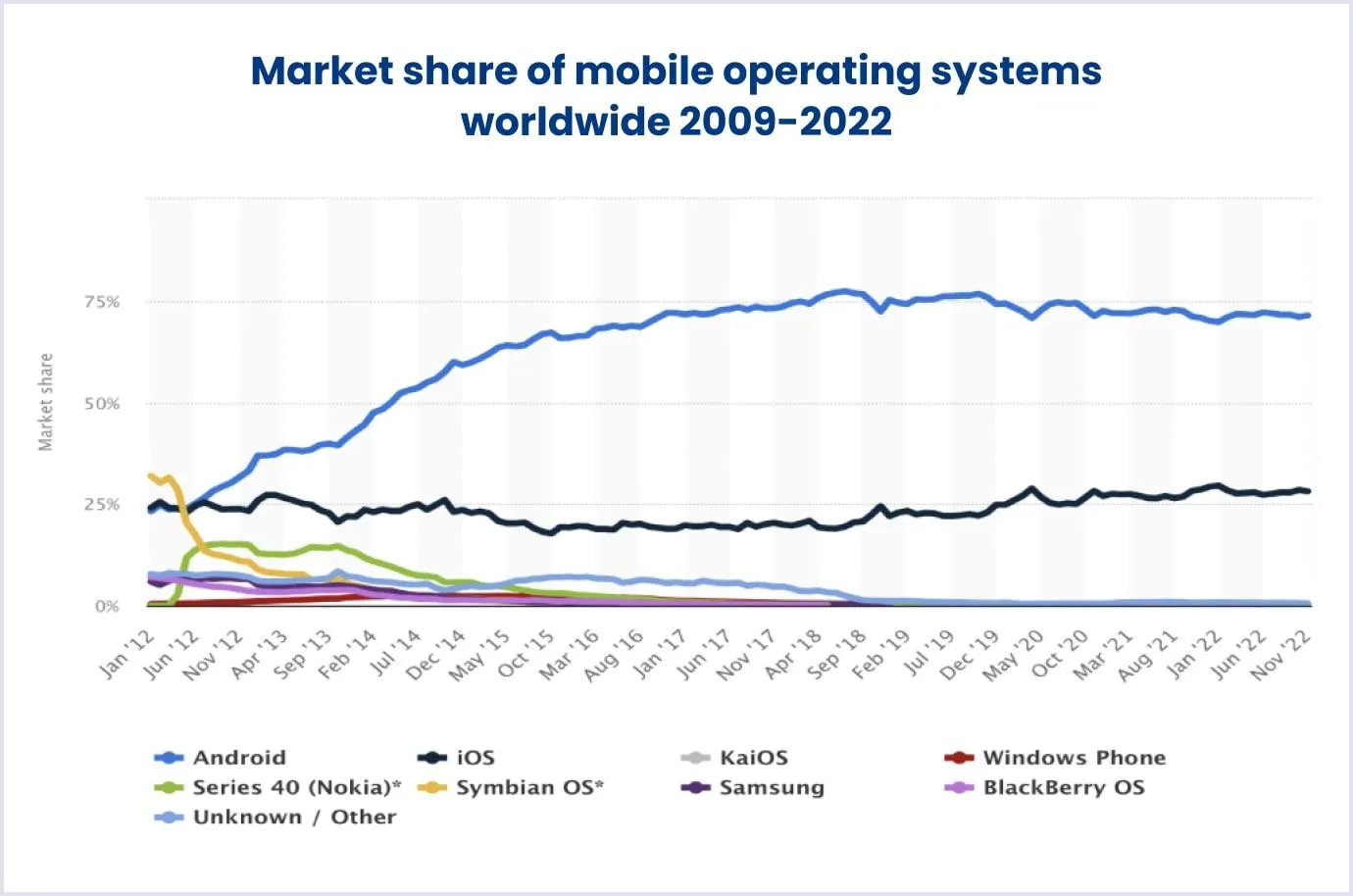
Source: Statista.com
In the case of mobile applications, there are native and hybrid (or cross-platform) versions. Native apps are software programs that are specific to a particular platform.
In comparison to hybrid apps, native apps have excellent functionality and a high user experience, but they take longer to develop and cost more. Thus, native mobile app developer requires specific technology stacks and specialist resources.
In other words, hybrid apps combine elements of both native and web apps. They are designed using technologies that give them cross-platform functionality.
Hybrid apps are cost-effective, faster, and easier to develop, but they have such drawbacks as test complexity and lower performance.
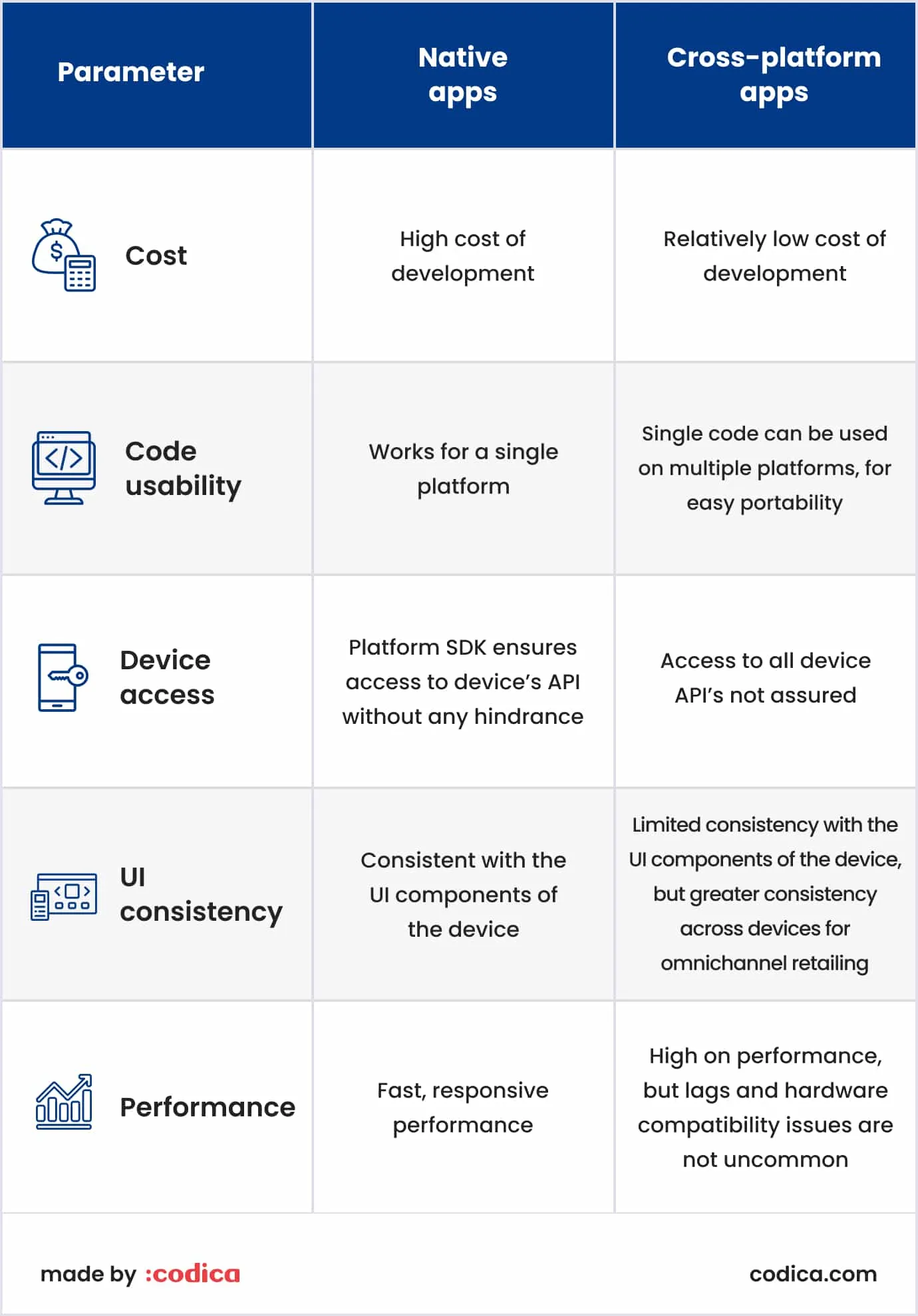
For mobile development and maintenance processes, each type of mobile app requires specific programming languages, tools, and technologies. Let's explore them in more detail below.
Android App Technology Stack
The Android mobile application market has a larger share than iOS, so let's first examine the Android app stack.
Android Programming Languages
Mobile application development can be done using a variety of different languages. The most popular Android programming languages are Java and Kotlin.
Because Java is an object-oriented programming language that has a modular structure that makes it easy to solve problems, it's the most popular language for developing Android apps. There are many benefits to using Java for mobile app development, including widespread popularity, security, robustness, numerous features that affect app performance, like Just-In-Time compilation, and community support.
It is compatible with Java virtual machine (JVM), so you can use Java frameworks for developing the app. Kotlin is a statically typed programming language that enables developers to compile code into Java. Its main advantage is that it compiles code faster. However, Kotlin is still an evolving language, so support of new Android app development devices still has configuration issues and limitations.
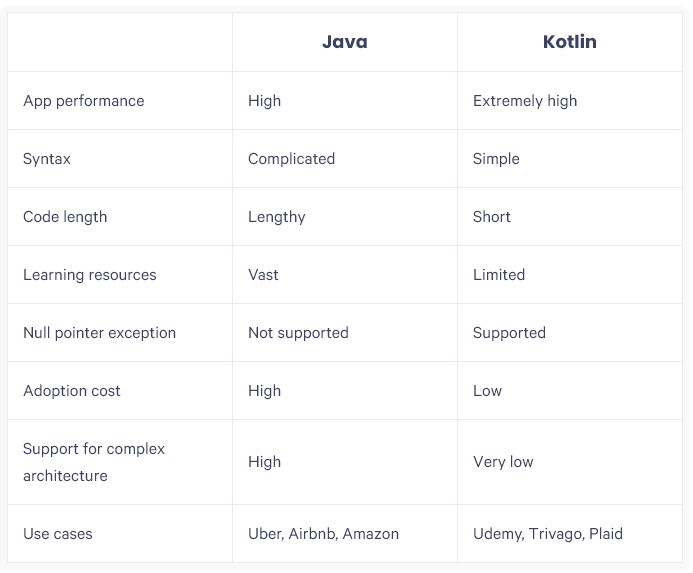
Tools for Developing Android Apps
A development tool is a program used by software developers to build, test, maintain or support other programs and apps. In order to choose the best technology stack that meets the functional requirements of your business, you need to analyze its features and requirements before choosing a mobile app technology.
Mobile app development tools are also divided into two categories: Android and iOS.
Mobile App Development Tools for Android:
· Integrated development environment optimized for Android apps is provided by Android Studio. It offers a visual layout editor, a fast emulator, a smart code editor and templates that make it a great tool for mobile app development. Using Android Studio, you can build an Android app with the latest features.
· A variety of components can be downloaded separately from the Android Software Development Kit (Android SDK). Besides code samples, libraries, documentation, and guides, the Android SDK also lets you add a 2GIS map to your Android app. You can use it to add unique markers, estimate routes, and obtain information about map objects.
Do you want to know which companies use these tools? Here are some examples.
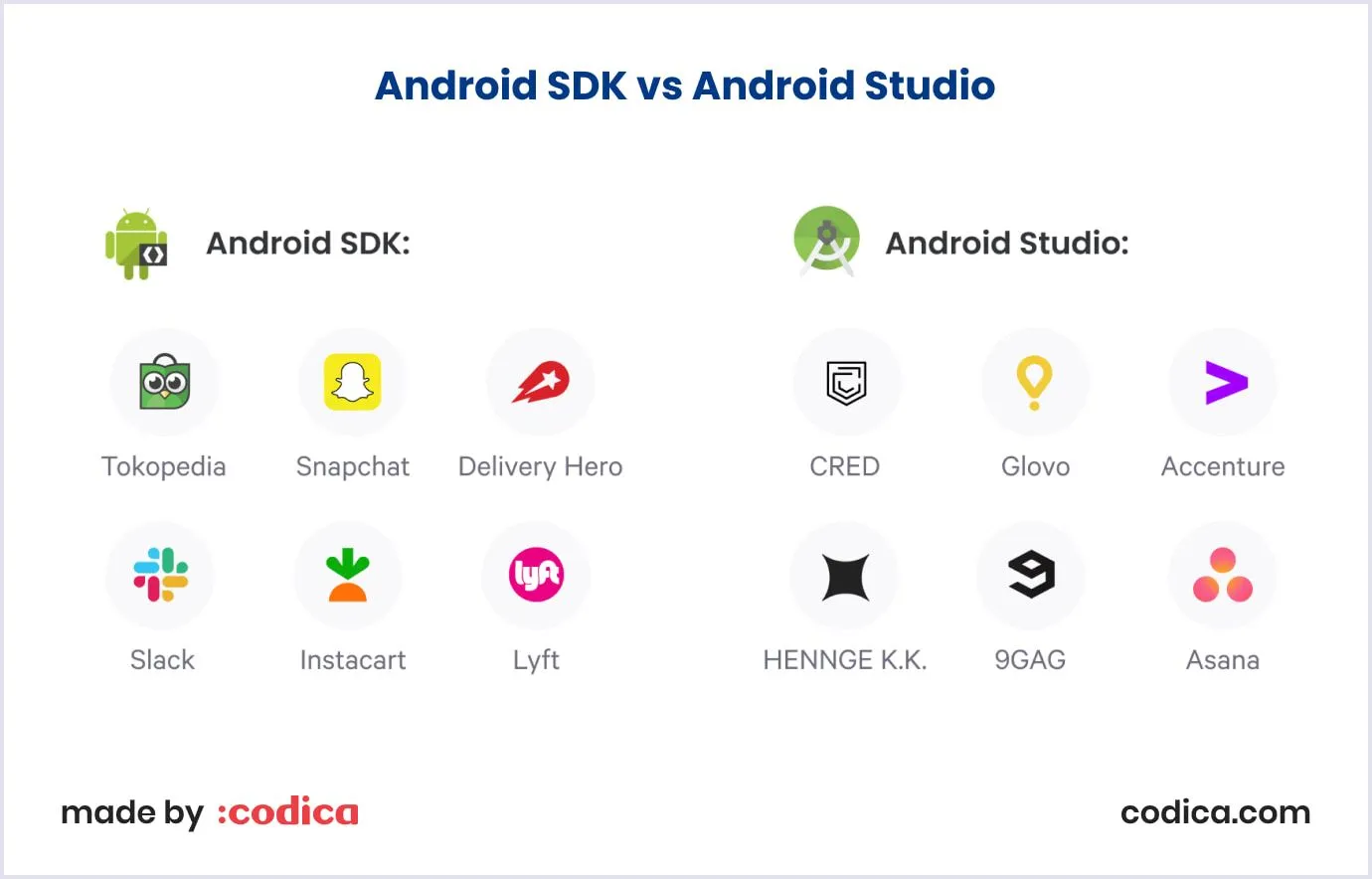
Frameworks for Android Mobile Apps
How do we understand the UI framework (or user interface framework)? It is a system for building and modifying user interface components. It is the software that defines a structure for user interfaces. Mobile applications can be developed using UI frameworks for Android and iOS.
Android Mobile App UI Frameworks:
Aside from templates for faster building user interfaces, Android UI offers action bars and content areas: view control, content area, main action bar, and split action bar.
The Jetpack Compose framework helps to create the user interface. A modern toolkit for building native apps for Android has a simple UI for Android development. This stack offers simpler code, powerful tools, and intuitive Kotlin APIs. With Jetpack Compose, you can build your app in no time by using intuitive Kotlin APIs and appropriate tools.
Check out this video to see why Jetpack Compose UI is an intuitive and powerful UI framework.
App Technology Stack for iOS
We will discuss in a detailed manner the technology stacks to be used in iOS mobile app development that makes the platform user-friendly.
iOS Programming Languages
iOS app development is primarily done with Objective-C and Swift programming languages. Both have their own features and can be tailored to your business needs.
It is a strict, complex programming language with good data protection features. It is compatible with various Apple platforms, including iPhones, Macs, Apple TVs, and iPads.
Although Objective-C was last updated in 2016, developers may still use it for certain components that have not yet been ported to Swift.
Its expressive syntax makes it easier to develop mobile apps. Developers can save time writing mobile apps with Swift because it has an automatic memory management system and concise code. There are a number of data structures, flow controls, and protocols in Swift. Swift is also cross-platform, particularly for Windows and Linux.
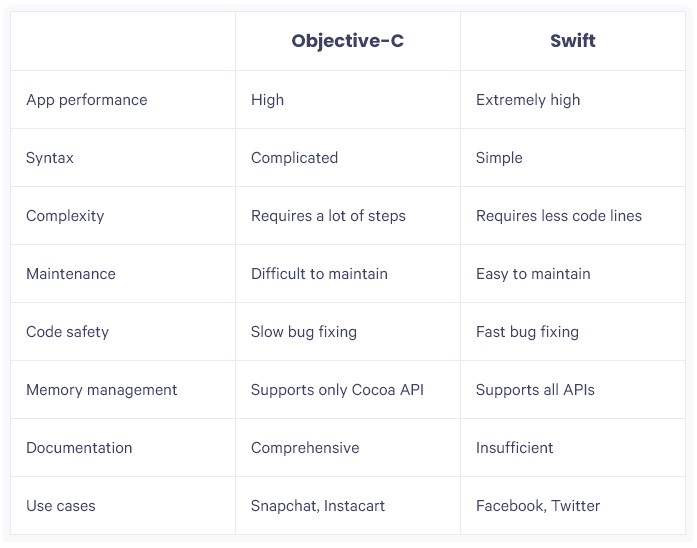
The PYPL index survey shows that 2.23% of respondents use Swift, whereas 2.22% use Objective-C, making it an approximate 1:1 ratio.
App Development Tools for iOS
We've compiled a list of the top iOS development tools that can help you create better apps and streamline your development process.
The first thing we need to understand is that IDEs (integrated development environments) are comprehensive environments for writing, testing, and debugging code. SDKs (software development kits) are a set of tools, libraries, and documentation for specific platforms or technologies. It is possible to develop applications for a platform using an SDK within an IDE.
Here is a List of iOS Mobile App Development Tools:
In iOS app development, both Apple Xcode and AppCode are used, with Xcode being Apple's official and most widely used IDE.
In addition to Xcode and AppCode, the iOS Software Development Kit (iOS SDK) contains developers' tools and frameworks. The choice between AppCode and Xcode is often based on personal preference and specific development needs.

Frameworks for iOS Mobile Apps
SwiftUI, UIKit and others frameworks allow you to manipulate the iPhone or iPad camera, add voice interaction with SiriKit, and explore music with MusicKit.
For iOS Mobile Apps, Here is a List of UI Frameworks:
• SwiftUI is a modern framework developed by Apple to build user interfaces for iOS. Lists, stacks, buttons, selectors, and other components can be used in this framework. As well as providing tools for creating custom views, animations, and gestures, SwiftUI also offers easy theme management and straightforward code generation.
· UIKit is a powerful framework for developing apps on iOS, iPadOS and tvOS. It provides components to create the core structure of your app and works seamlessly with SwiftUI – you can use elements from both frameworks to design your interface. Furthermore, UIKit offers numerous features including support for animation, documents, drawing and printing, text management and display, search, app extensions and resource management. Additionally it allows you to retrieve information about the current device.
You can see a detailed comparison of SwiftUI and UIKit by building a complete project in the video below.
Mobile app development requires choosing the right UI framework. Each framework has its advantages and disadvantages, so you must choose the tech stack according to your app features and business goals.
You should pay attention to your user interface when creating a mobile app because your customers interact with it every day. That's why you should improve the user experience as much as possible to boost customer satisfaction.
Ultimately, we highlight the best UI frameworks for developing iOS or Android apps.
If you have any questions, please don't hesitate to Contact Me.
Back to Blog